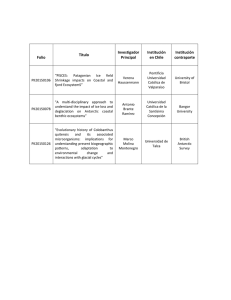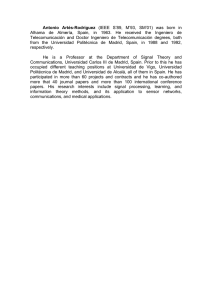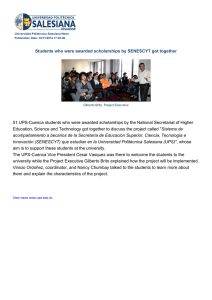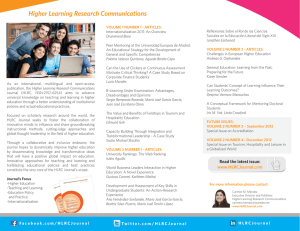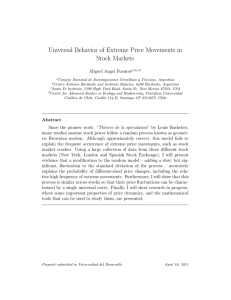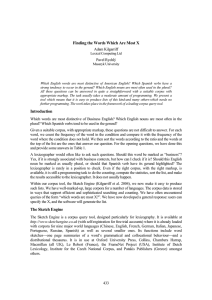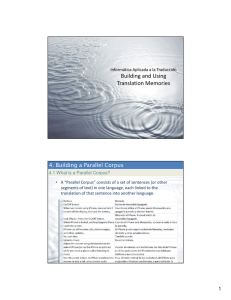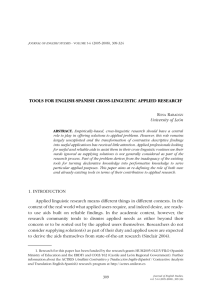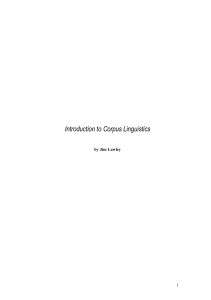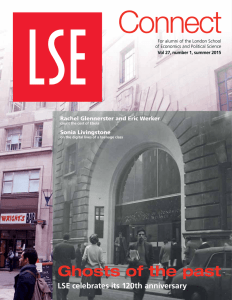Coordinador
Anuncio
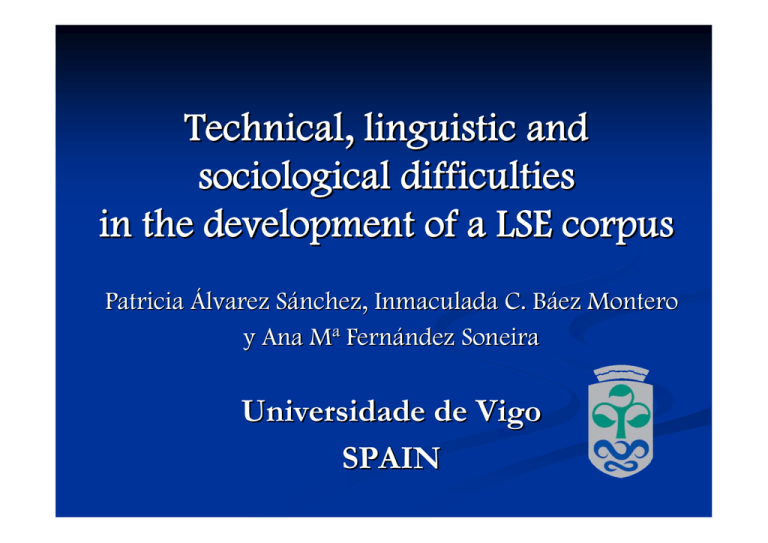
Technical, linguistic and sociological difficulties in the development of a LSE corpus Patricia Álvarez Sánchez, Inmaculada C. Báez Montero y Ana Mª Fernández Soneira Universidade de Vigo SPAIN 1 > Introduction 2 > Data 3 > Analysis 4 > Future projects 5 > Acknowledgments 6 > Bibliography Let’s see a sample view of our web page… Our long journey… The first stage covers our group work from 1995 until 2000 and it represents the beginning of the process. The second phase goes from 2000 till 2007. It was stressed by an analysis process of the work done, and reconsiderations on our basis due to the problems arisen in the first stage. The third and last stage corresponds to present time. It is the time of showing our advances and the decisions made on the linguistic, sociolinguistic and technical aspects. Our corpus… What is it? A group of real linguistic data that is stored in an electronic medium (computer, video, etc.) gathered with the aim of studying a language or a variety of it. How is it? It is representative of different social groups and linguistic styles. It has also been computerized. What do we need it for? It makes possible the grammatical description of a language based on real data. It makes also easy to compare the different sign languages. 1 > Introduction 2 > Data 3 > Analysis 4 > Current state 5 > Acknowledgments 6 > Bibliography Informants’ data We have developed an interview filing card with the purpose of ascertaining the social and linguistic profile of the Galician deaf people that were later registered in videotapes. The questions in the cards are easily understandable and the identity of the informant is safeguarded in every case. This is the data gathered from our 85 informants: 1. Identification: name, address and phone (for future contacts); 2. Origin and social environment: place and date of birth, age of deafness occurrence, deafness degree, deaf/hearing family, job of closest family members; 3. School: degree and type of studies, special/ordinary school, use/absence of SL in school; 4. Linguistic skills: in LSE, in oral Spanish, lip-reading, written Spanish; 5. Place of residence: in order to reflect and control linguistic variation. Let’s see a sample view of our informants’ database… Language samples Guided monologue We ask the deaf informant to describe his family and his house, to tell a short story, etc. Thus, we obtain both description and narration, but the results are not completely natural. Semiguided interview Signers are interviewed (deaf people, most of all) on diverse topics, depending on their age, preferences, etc. The objective is to obtain natural signing, as spontaneous as possible. Public discourse (conferences, round tables, etc.) These give us programmed discourse in a more formal style. Guided monologue sample Semiguided interview sample Public discourse sample Our aims… Our work has focused on obtaining a LSE textual corpus of Galician signers from which to start the research on LSE. These were our initial researching aims: Starting the description of LSE Determining which are the relevant linguistic units in SL Understanding the grammatical relational processes Developing tools for research: labeling, transcription, etc. Corpus features We considered these the main features of a corpus: It must contain real data. It must constitute an irreplaceable basis for linguistic description. It must be completed with computing support in order to make easy its use. It must gather: a) Informants data b) Different types of discourse samples c) Wide range of topics depending on the type of discourse we want to obtain, etc. It must be transcribed in Spanish glossas (conventions adapted from Klima & Bellugi, 1979) and subtitled in written language. Type of discourse distribution 5% 31% 64% Guided Monologue Semiguided interview Public discourse Age distribution 6% 16% 78% 21-34 years 35-50 years > 50 years Gender distribution 44% 56% Male Female Process stages We have divided into seven stages the process of creating our corpus: a. Tool design for the creation of a corpus b. Criteria for the selection of informants c. Creation of a database of informants’ details d. Collection of language samples e. Data storage f. Data labeling and marking g. Transcription and notation systems Difficulties in the process The lack of a research tradition on Sign Languages in Corpus Linguistics forces us to solve problems from the beginning: How to delimit units in sign languages. How to label the different formations for their later analysis. Other related issues. Creation of social networks in the Deaf community with the aim of avoiding the social identity of our informants to be threatened. Technical restrictions. We have to select appropriate material in order to avoid problems in compatibility between the different devices (video cameras, computers, software…) 1 > Introduction 2 > Data 3 > Analysis 4 > Future projects 5 > Acknowledgments 6 > Bibliography Analysis of the interviews We have put different strategies into practice for the recording of the interviews. These are the results of our experience: 1st strategy: hearing interviewer and deaf informant The results are not too natural “Foreign speaking” hazard Limited success 2nd strategy: contribution of an interpreter The participation of an interpreter in the interaction between the researcher and the informant is of great help. They contribute to creating a comfortable atmosphere. 3rd strategy: deaf interviewer and deaf informant The performance of deaf people as interviewers contributes to more natural dialogues and it involves the deaf community in the project. Reconsiderations After the research, we had to reconsider certain issues for a better development of our corpus. Revision of the projects carried out in other countries. Creation of social networks: Inside the Deaf community: Preparation of the members of the community for the carrying out of the interviews In the institutions: Participation in national networks in order to contact with the Deaf community all over Spain. Support of the LSE Standardization Center in the creation of the corpus. Linguistic and Sociolinguistic Decisions LSE is not an standardized language and there are very few descriptive studies on this language. This forces us to propose what kind of recordings do we want, how many people do we need in order for the corpus to be representative and real, and finally, what conclusive analysis could we obtain from it. Taking into account these determining factors, we have decided: Ask for the collaboration of signers of different regions of Spain for obtaining a good representation of the different geographic registers. Select signers that fulfill certain features: native signers of LSE, post lingual users of LSE and interpreters. Choose deaf interviewers. Their dialogues are more natural and they obtain a higher degree of involvement of the Deaf community in this project. Recordings should be adapted to the personality of the informants. We have prepared several models of the interview, with questions that may arouse interest in the informants (on deafness, family, friends, tobacco, etc.) Technical decisions with a view to the future 1. Standardization of the recording format. Use of a recording set: similar wall background, light conditions, signers clothes, position and framing. 2. Multiple views of the signer: face, trunk, in profile, etc. 3. Storage and backup of the recordings from the camera to the computer. 4. Editing of the recordings in chapters for a better handling of the images. 5. Use of the ELAN system for the notation process. 6. Corpus labeling of grammatical features and sign configuration. 7. Use of P2P tools for making easy the cooperation between universities or research groups. 8. Enable the search and retrieval by sign configuration, grammatical aspects and signer details. 9. Online publishing of the corpus with the aid of external financing. 1 > Introduction 2 > Data 3 > Analysis 4 > Future projects 5 > Acknowledgments 6 > Bibliography Advances We are members of a network of universities for the teaching and research on Spanish and Catalan Sign Languages (RIID-LLSS). We collaborate in the creation of a LSE Standardization Center (whose creation will be possible thanks to the pass of the Law 27/2007, 23 October, on the Use and Recognition of the Sign and the Support Media for Oral Communication). Our group has obtained state financing for its research project “Basis for the linguistic analysis of the Spanish Sign Language” We count with three deaf teachers and four interpreters for the research and teaching tasks. We also count with specialized researchers in subtitling that will deal with the subtitling and marking tasks in the corpus. In these years, several thesis and dissertations of PhD students on topics related to sign language linguistics have been published (Fernández Soneira 2004; Iglesias Lago 2006, Álvarez Sánchez 2006; Cabeza y Fernández 2004). Current aims We are working for creating a textual corpus of LSE as a basis for: Development of LSE grammars. The grammatical Applied research: LSE interpretation, LSE teaching, General research: Language acquisition, Linguistic Use of the corpus in the teaching platforms as a analysis will focus on the determination of the relevant LSE units and the grammatical processes of relation. Normalization and linguistic planning, Transcription, etc. universals and other related issues. didactic element in order to provide the pupils with real language simples. Sample search in the future corpus 1 > Introduction 2 > Data 3 > Analysis 4 > Future projects 5 > Acknowledgments 6 > Bibliography Acknowledgements This work is part of a larger research project carried out by the Research Group on Sign Languages at the University of Vigo. Its final outcome, in the form of this paper, would not have been possible without the collaboration of Francisco Eijo Santos and Juan Ramón Valiño Freire (two of our deaf collaborators). This research was funded by the Ministry of Education and Science, grant number HUM2006-10870/FILO. This grant is hereby gratefully acknowledged. 1 > Introduction 2 > Data 3 > Analysis 4 > Future projects 5 > Acknowledgments 6 > Bibliography Bibliographic References Alvarez Sanchez, P. (2006) “La enseñanza de lengua extranjera a alumnos sordos”. Diploma de Estudios Avanzados (Universidad de Vigo). Báez Montero, I. C. & M. C. Cabeza Pereiro (1995) "Diseño de un corpus de lengua de señas española", XXV Simposium de la Sociedad Española de Lingüística (Zaragoza). Báez Montero, I. C. & M. C. Cabeza Pereiro (1999) "Elaboración del corpus de lengua de signos española de la Universidad de Vigo", Taller de Lingüística y Psicolingüística de las lenguas de signos (A Coruña). Báez Montero, I. C. & M. C. Cabeza Pereiro (1999) "Spanish Sign Language Project at the University of Vigo" (poster), Gesture Workshop (Gifsur-Yvette, Francia). Cabeza Pereiro, C. & A. Fernández Soneira (2004) “The expression of time in Spanish Sign Language”, Sign Language and Linguistics, 7 (1) pp63-82. Fernández Soneira, A. (2004) La cuantificación en la lengua de signos española, Universidad de Vigo, Tesis doctoral. Iglesias Lago, S.(2006): “Uso del componente facial para la expresión de la modalidad en lengua de signos española”, Universidad de Vigo, Tesis doctoral inédita. López Morales, H. (1994) Métodos de Investigación Lingüística. Ediciones Colegio de España: Salamanca. Martí Antonín, Mª A. (1999) “Panorama de la lingüística computacional en Europa”, Revista Española de lingüística Aplicada, 11-24. Other corpora UNIVERSIDAD DE CALIFORNIA BERKELEY Base de datos y transcripciones de la Lengua de Signos de Holanda. Coordinadores: Dan Slobin & Jennie E. Pyers. UNIVERSIDAD DE NJMEGEN Creación y notación de un corpus (±120 horas) Coordinador: Onno Crasborn. UNIVERSIDAD DE BÉLGICA Grabación en video sin digitalizar (±10 horas) Coordinadora: Myriam Vermeerbergen. UNIVERSIDAD DE OREBRO (SUECIA) Base de datos en vídeo que recoge situaciones naturales en el aula. Coordinadora: Sangeeta Bagga Gupta. UNIVERSIDAD DE ESTOCOLMO “Digital version of Swedish Sign Language Dictionary” (6000 clips) Coordinador: Brita Bergman CENTRO NACIONAL DE INVESTIGACIÓN EDUCATIVA Diccionario de lengua de signos noruega. Creación de un corpus en lengua de signos noruega digitalizado. Coordinador: Svein Arne Peterson UNIVERSIDAD DE AMSTERDAM Digitalización de un corpus (±500 horas). Coordinadores: Anne Baker y Ybonne Jobse UNIVERSIDAD DE MAGDEBURG Proyecto Berlín: 200 horas de grabaciones de signantes sordos utilizados para la elaboración de materiales de enseñanza. Proyecto Hamburgo: 20 horas de grabaciones de signantes sordos. Proyecto Magdeburg: 4 años. Coordinadores: Andreas Goeze y Jens Hebman UNIVERSIDAD DE PARÍS 8 30 horas de grabación convertidas en Quick-Time clips in Cd and DVD for LS-COLIN Project. Coordinadores: Christian Cuxac and Marie-Anne Sallandre INSTITUTE OF COGNITIVE SCIENCES AND TECHNOLOGIES (ISTC), National Research Council (CNR) 200 horas de grabación: adult and child LIS corpora. Corodinadora: Elena Pizzuto UNIVERSIDAD CENTRAL DE PRESTON (LANCASHIRE) Análisis de la lengua de signos británica de los intérpretes al traducir para sordos de la escuela secundaria (40 horas) Coordinador: Frank Harrington UNIVERSIDAD DE KAGENFURT (AUSTRIA) Análisis electrónico de léxico en lengua de signos. Coordinador: Franz Dotter UNIVERSIDAD NACIONAL DE AUSTRALIA (CAMBERRA) [Centro de Investigaciones de Tipología Lingüística] Corpus de discurso libre en lengua de signos de India y Pakistan. Analizado con el CHILDES. Proyecto de análisis tipológico de interrogativas y negativas en lenguas de signos. Coordinador: Ulrike Zeshan UNIVERSIDAD VICTORIA DE WELLINGTON (NUEVA ZELANDA) Analizadas y transcritas cerca de 100.000 palabras signadas. Una glosa para cada palabra analizada con el WordSmith. Coordinadores: Graeme D. Kennedy & David McKee UNIVERSIDAD DE BOSTON Proyecto que incluye una herramienta para transcribir y analizar los datos (SIGN STREAM) Coordinador: Robert G. Lee UNIVERSIDAD DE HAMBURGO Proyecto internacional sobre publicaciones en lengua de signos: “SIGNING BOOKS” Coordinador: Liesbeth Pyfers UNIVERSIDAD DE NUEVO MÉXICO Corpus de LSA en vídeo. Base de datos con información sobre sexo, edad, diferencias sociales, etc. Coordinador: James MacFarlane Contact us Our webpage: www.webs.uvigo.es/lenguadesignos/sordos/home Patricia Álvarez: [email protected] Concha Báez: [email protected] Ana Fernández: [email protected]
